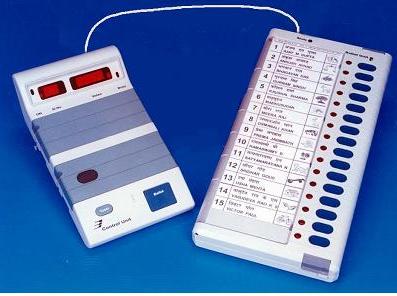 Electronic Voting Machine (EVM) retains all the characteristics of voting by ballot papers, while making polling a lot more expedient. Being fast and absolutely reliable, the EVM saves considerable time, money and manpower. And, of course, helps maintain total voting secrecy without the use of ballot papers. The EVM is 100 per cent tamper proof. And, at the end of the polling, just press a button and there you have the results
Electronic Voting Machine (EVM) retains all the characteristics of voting by ballot papers, while making polling a lot more expedient. Being fast and absolutely reliable, the EVM saves considerable time, money and manpower. And, of course, helps maintain total voting secrecy without the use of ballot papers. The EVM is 100 per cent tamper proof. And, at the end of the polling, just press a button and there you have the results
The EVMs were devised and designed by Election Commission of India in collaboration with two Public Sector undertakings viz., Bharat Electronics Limited, Bangalore and Electronic Corporation of India Ltd., Hyderabad. The EVMs are now manufactured by the above two undertakings. EVms was first used in 1982 in the bye-election to Parur Assembly Constituency of Kerala for a limited number of polling stations (50 polling stations). Indian voting machines use a two-piece system with a balloting unit presenting the voter with a button (momentary switch) for each choice connected by a cable to an electronic ballot box.
The innovation of the Bharat Electronics Limited, Bangalore and Electronic Corporation of India Limited, Hyderabad, binds nearly 741 million voters, who are expected to press its buttons to register their votes across the nation during April-May.The EC said that it had altogether 13,68,430 EVMs and nearly 11 lakh of them would be used during the polls in April and May. The poll-panel officials added that the EVMs were not only proved to be tamper-proof and free of errors, but they are also easy to be carried to even the remotest polling booths An EVM consists of two units:
* Control Unit
* Balloting Unit
The two units are joined by a five-meter cable. The Control Unit is with the Presiding Officer or a Polling Officer and the Balloting Unit is placed inside the voting compartment. Instead of issuing a ballot paper, the Polling Officer in-charge of the Control Unit will press the Ballot Button. This will enable the voter to cast his vote by pressing the blue button on the Balloting Unit against the candidate and symbol of his choice.The microchip used in EVMs is manufactured in Japan and it is sealed at the time of import. It cannot be opened and any attempt to rewrite the program cannot be done without damaging the chip.A single ballot unit takes in the names of 16 candidates.Inside the control unit, hidden from you, is an extremely sensitive circuitry that takes care of common election errors or malpractices like vote duplication. For instance, if one were to press two or more buttons simultaneously, then no vote would be cast. Even if there was a micro-second difference in the pressing of the switches, the EVM is sensitive enough to trace and identify the twitch that was press first. And thus, by connecting four ballot units the EVM can accommodate a total of 64 candidates in a single election.
If the number of candidates is less than the maximum capacity of the EVM, the extra panels are masked before use.Before the commencement of poll, the Presiding Officer demonstrates to the polling agents present that there are no hidden votes already recorded in the machine by pressing the result button. Then he or she conducts a mock poll by asking the polling agents to record their votes and presses the result button to satisfy them that the result shown is strictly according to the choice recorded by them. Finally the clear button is pressed to clear the result of the mock poll before commencing the actual poll.Each Control Unit has a unique ID Number, which is painted on each unit with a permanent marker. This ID Number will be allowed to be noted by the Polling Agents and will also be recorded in a Register maintained for the purpose by the Returning Officer. The address tag attached to the Control Unit also will indicate this ID Number. This is to avoid replacement of a genuine EVM by another one. As soon as the voter presses the 'blue button' against the candidate and symbol of his choice, a tiny lamp on the left side of the symbol glows red and simultaneously a long beep sound is heard. Thus, there is both audio and visual indications for the voter to be assured that his vote has been recorded. As soon as the last voter has voted, the Polling Officer in-charge of the Control Unit will press the 'Close' Button. Thereafter, the EVM will not accept any vote. Further, after the close of poll, the Balloting Unit is disconnected from the Control Unit and kept separately. Votes can be recorded only through the Balloting Unit. Again the Presiding officer, at the close of the poll, will hand over to each polling agent present an account of votes recorded. At the time of counting of votes, the total will be tallied with this account and if there is any discrepancy, this will be pointed out by the Counting Agents.
Not only in India, these machines are creating a wave elsewhere too:
http://newshopper.sulekha.com/topic//sci/news/made-in-india-evms-in-dem…
